HD Digihuman Human Virtual Anatomy Table System
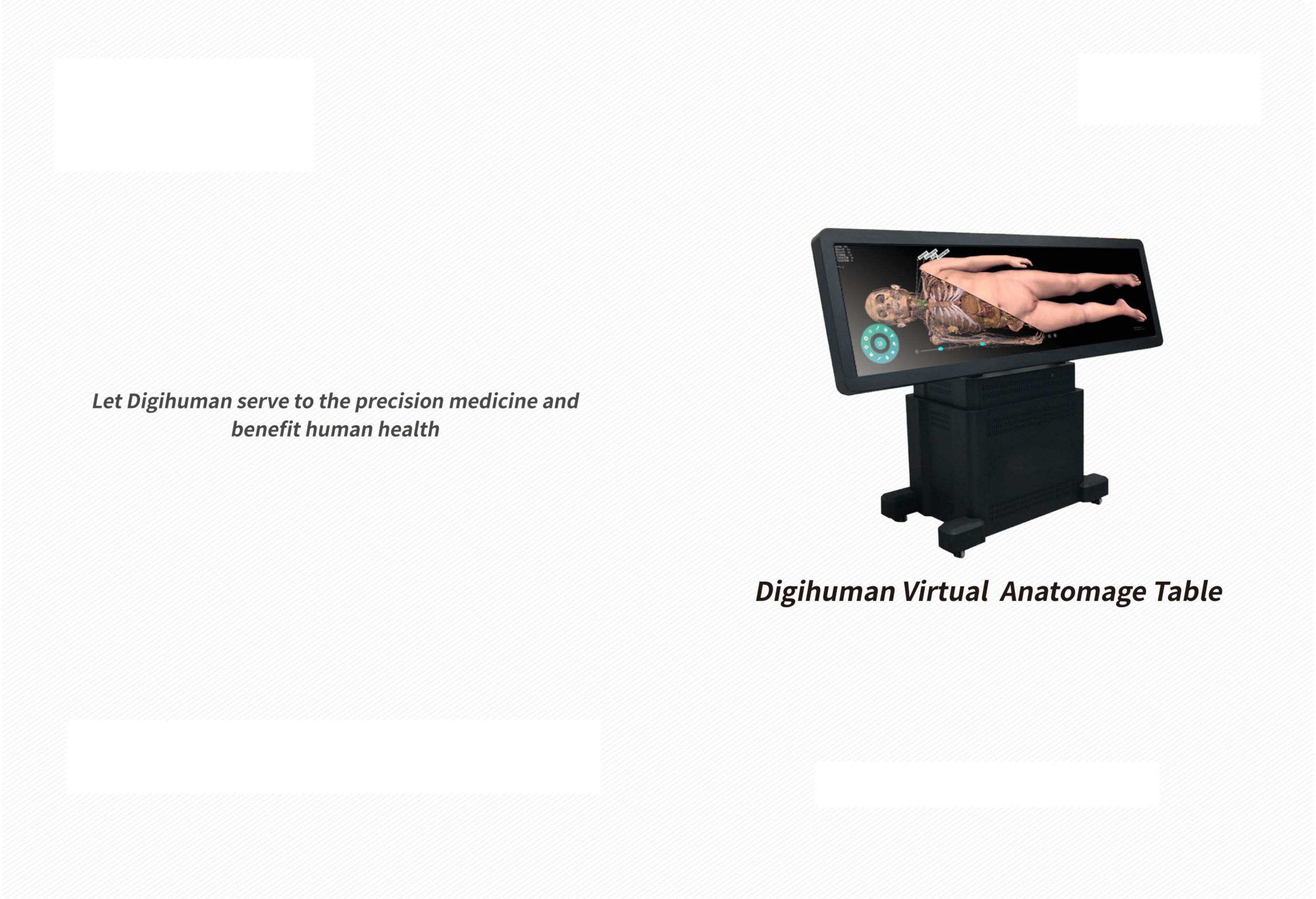
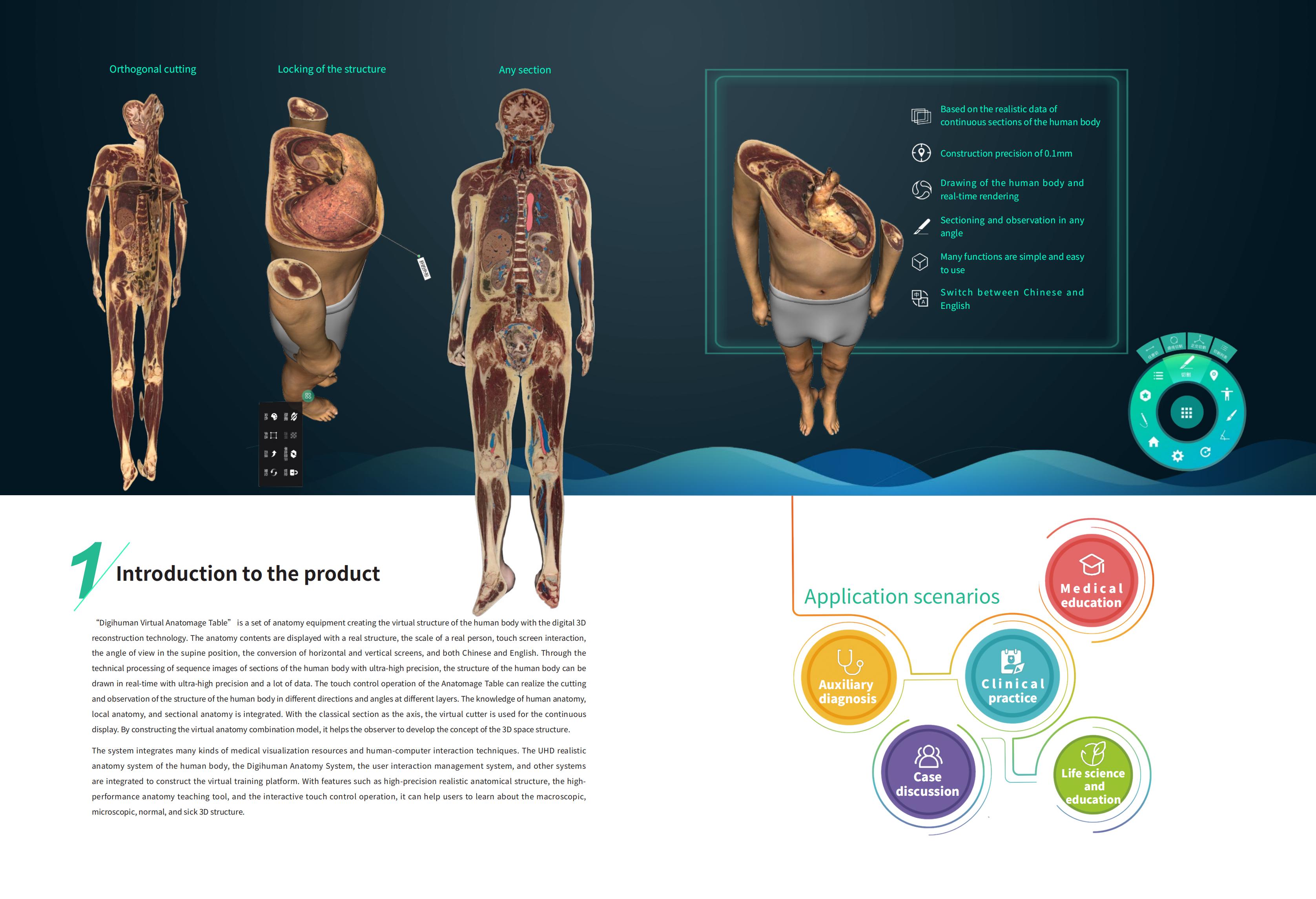
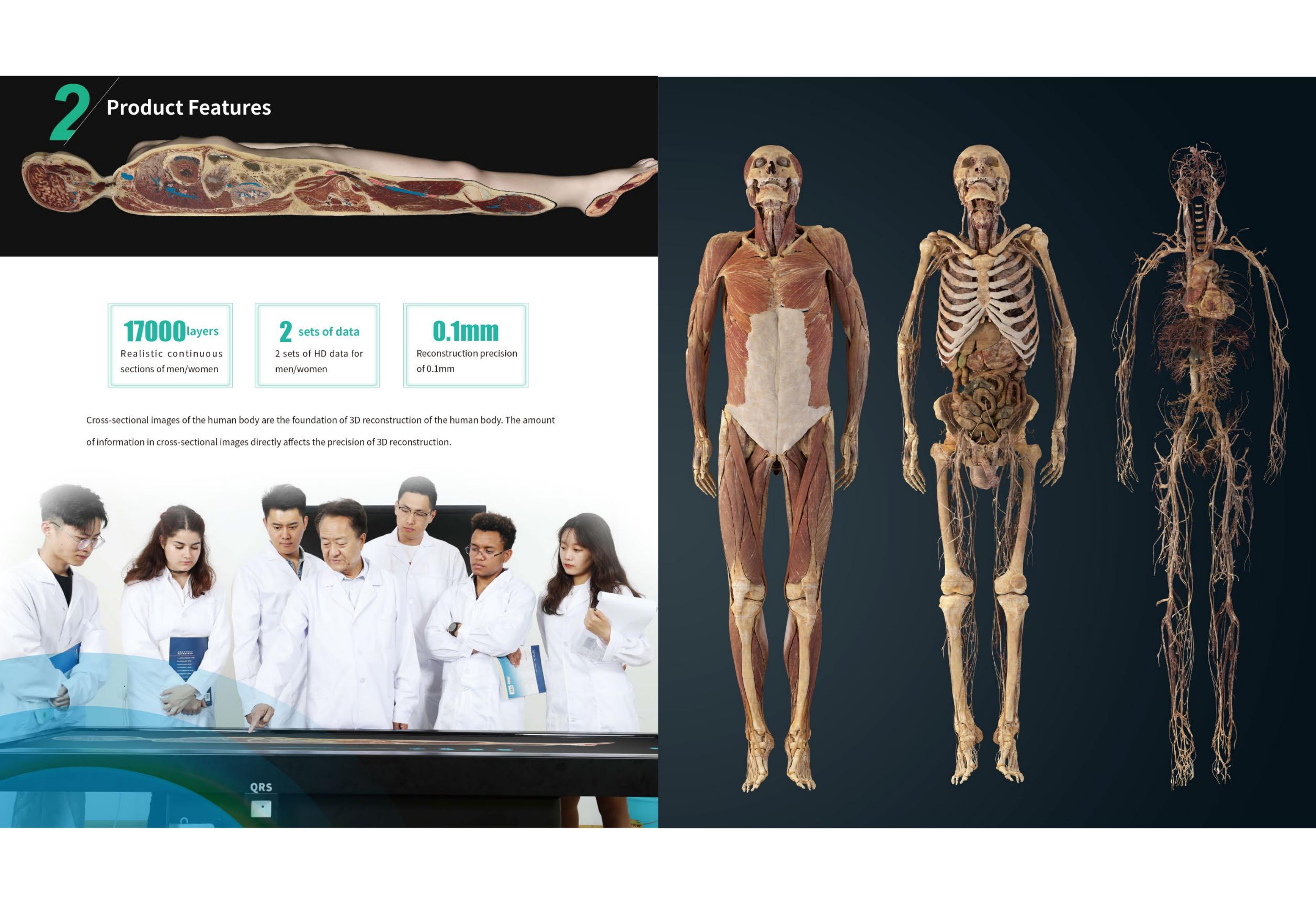
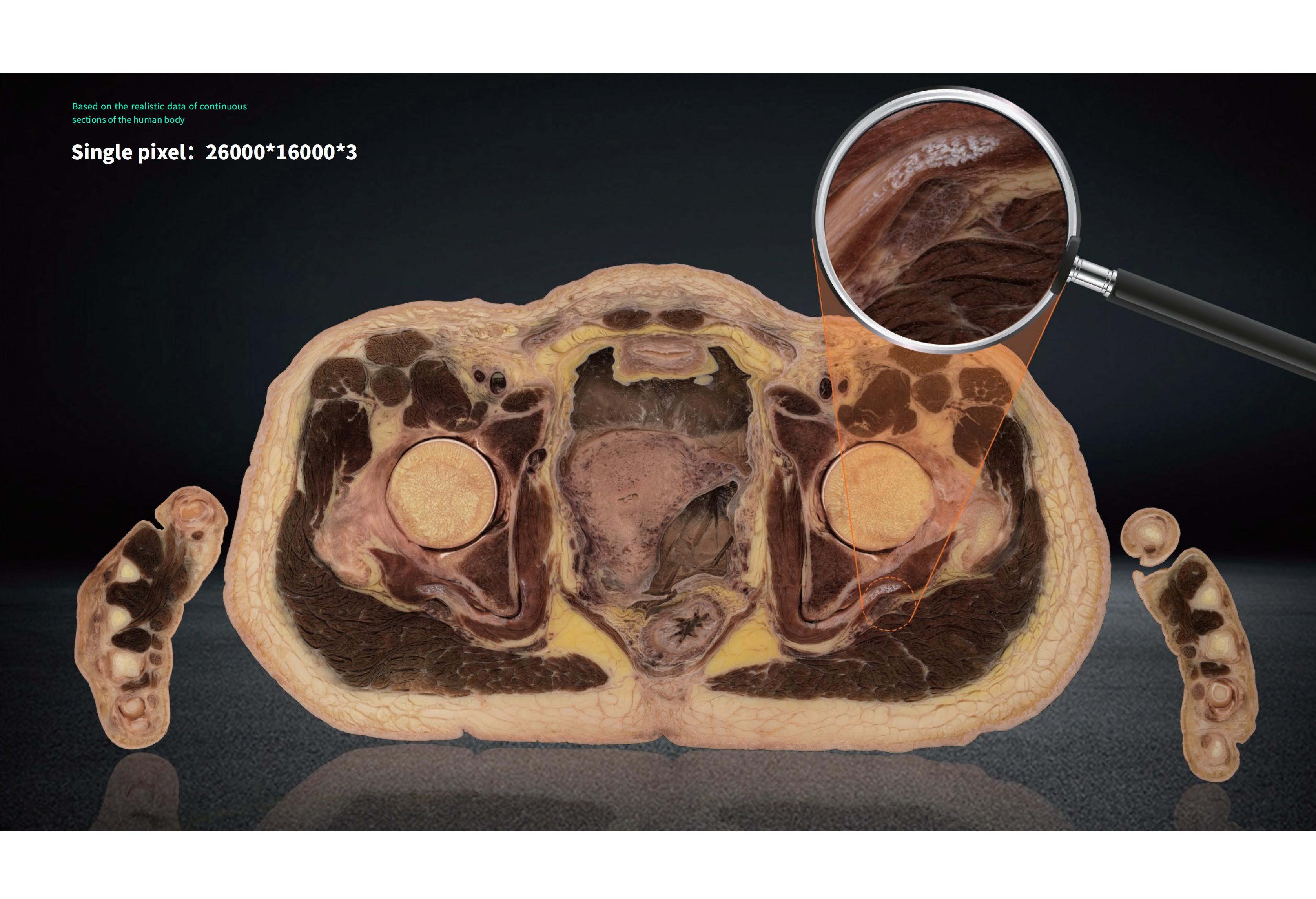
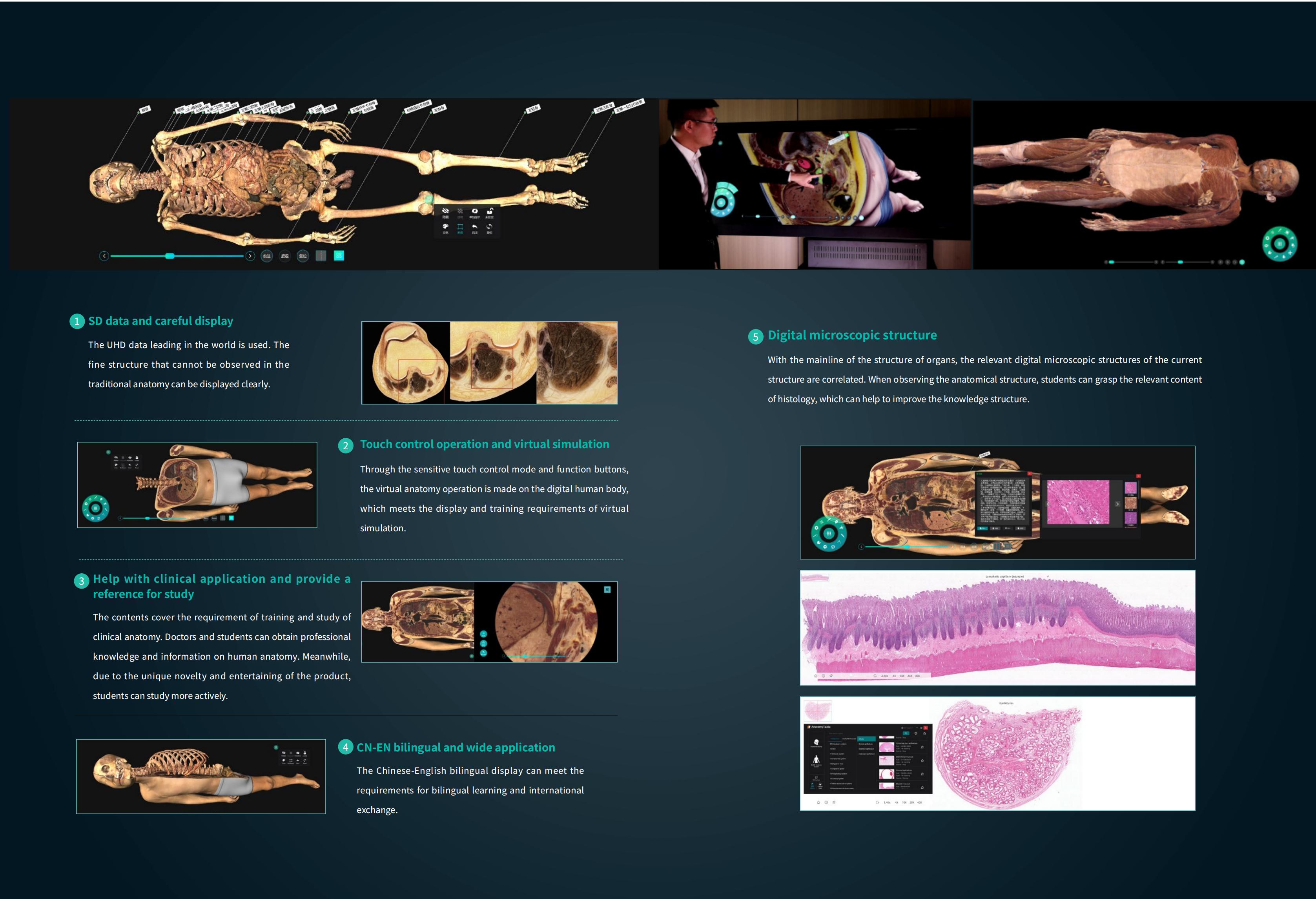
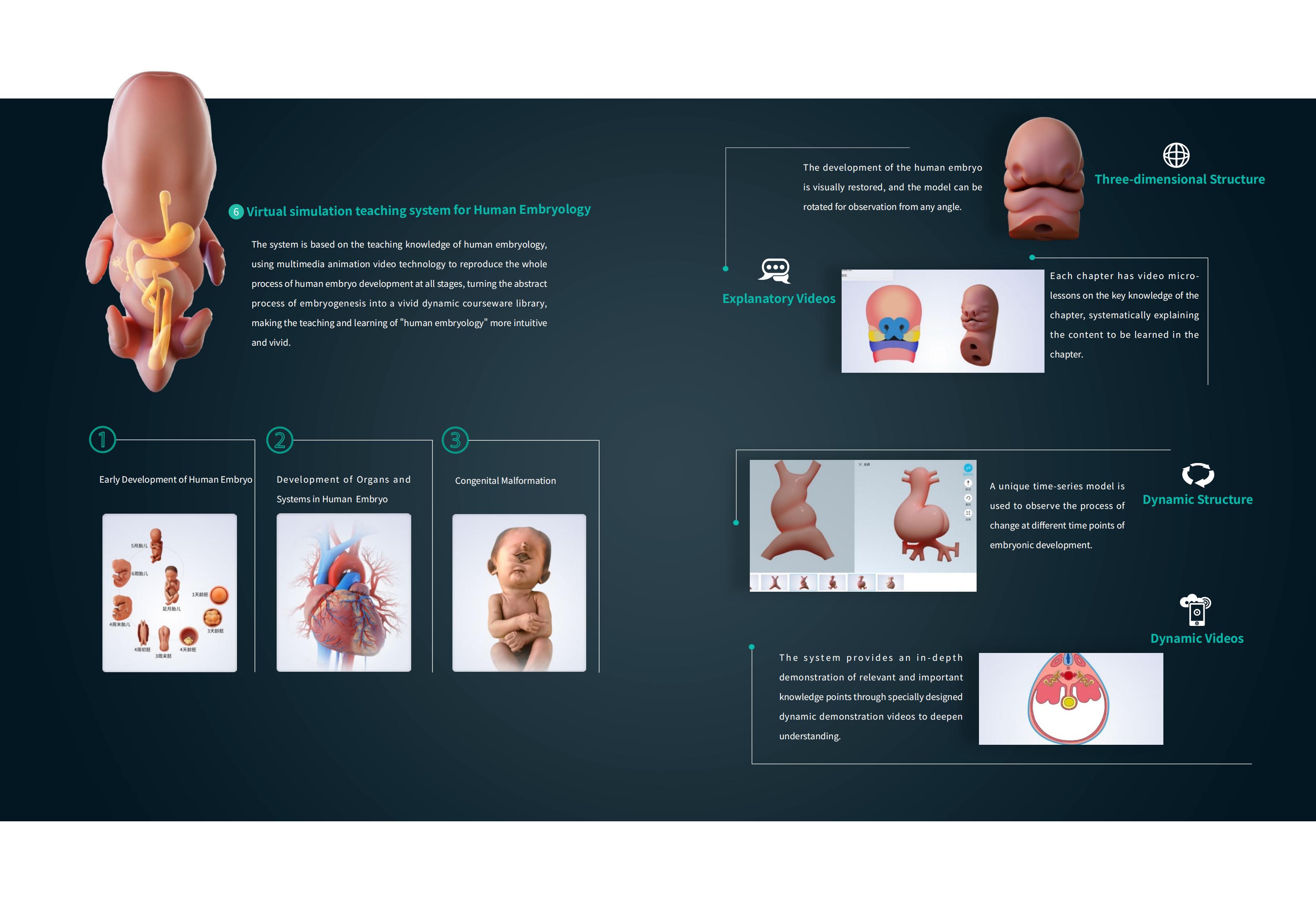
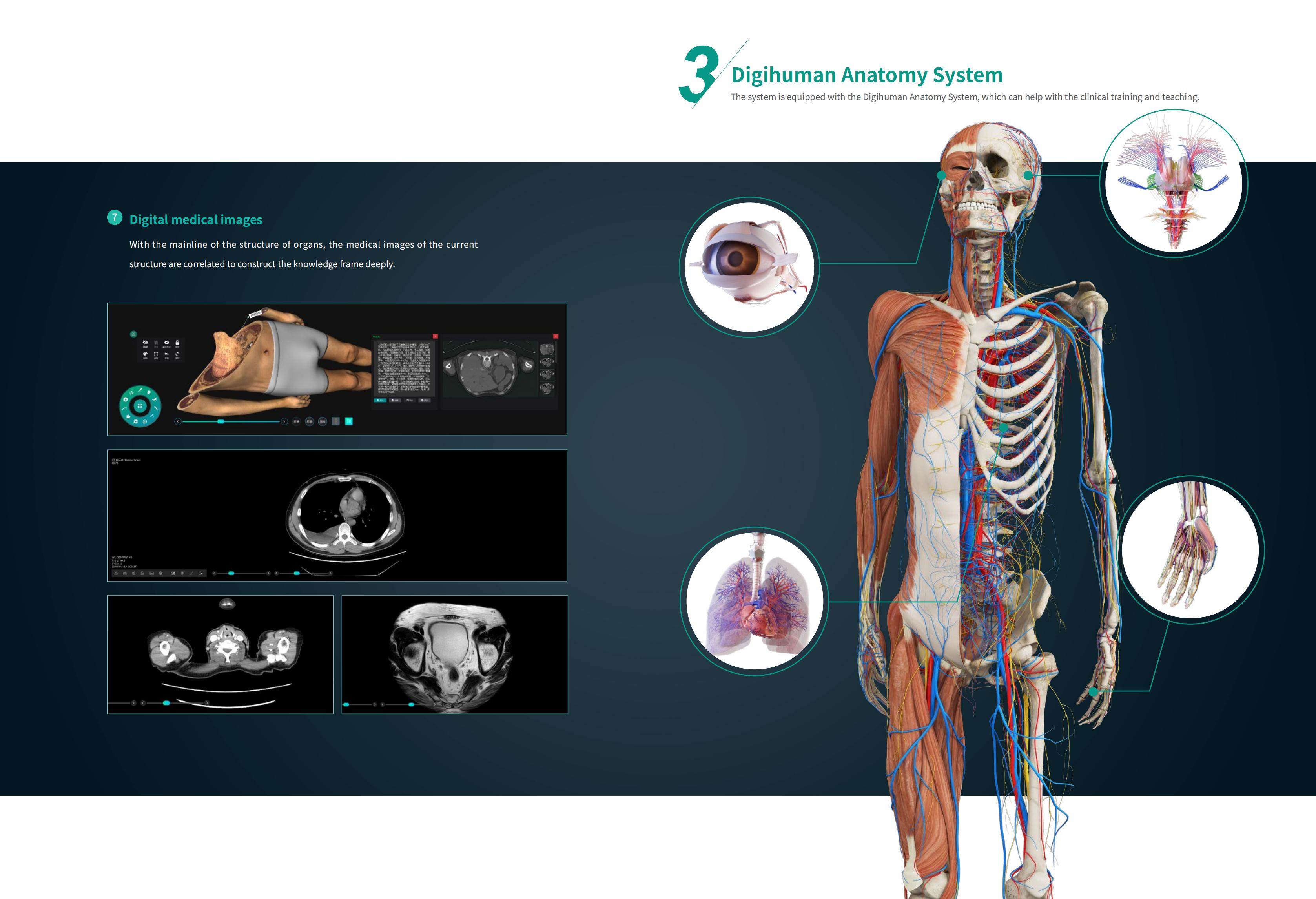
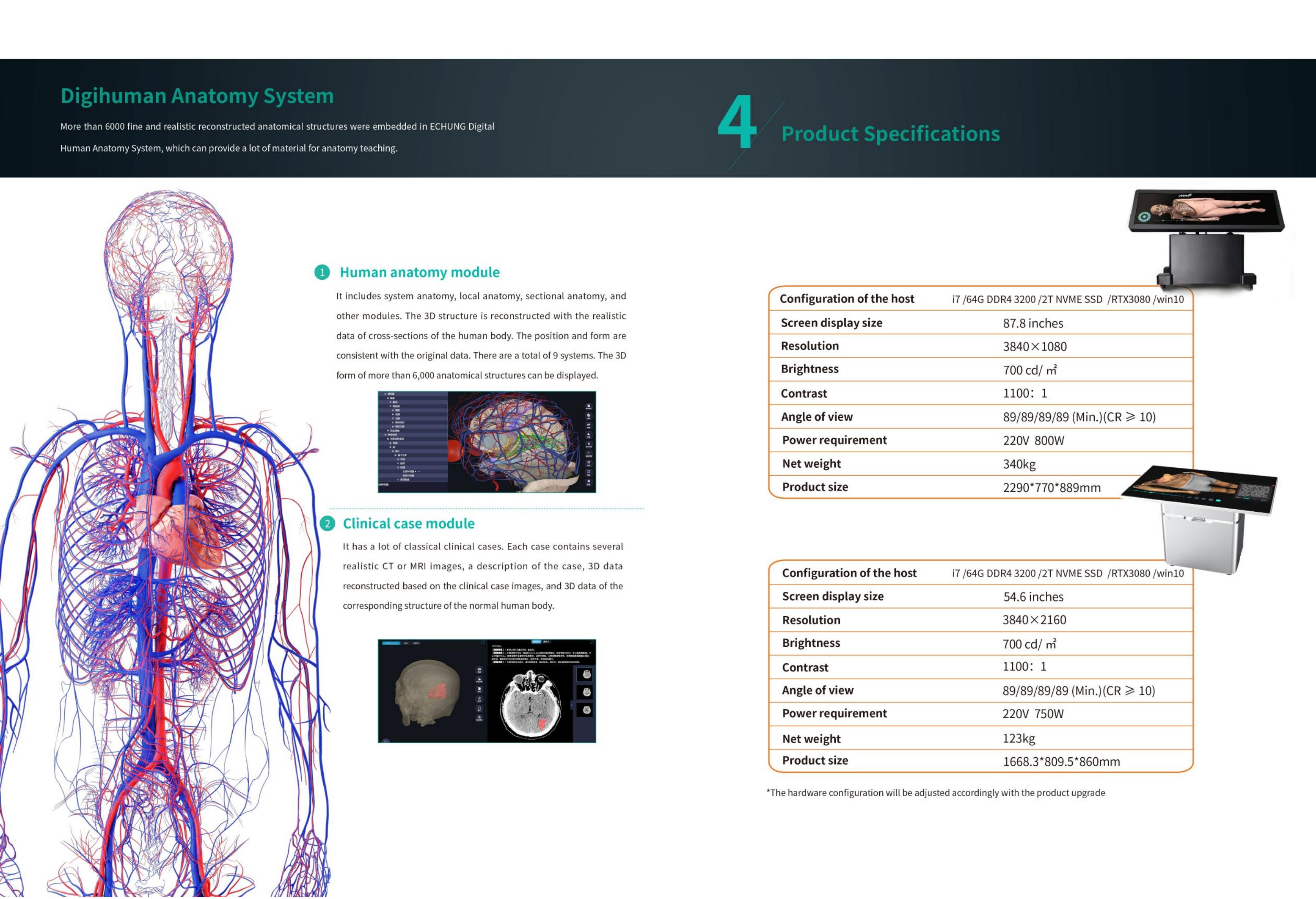
HD Digihuman Human Virtual Anatomy Table System
<!--[if !supportLists]-->1. <!--[endif]-->Hardware Overview: Model :YSDHA-II88 1.1 Computer Workstation: I7 above generation 10 /64G DDR4 3200 /2T NVME SSD /RTX3080 above 10G /win10(2) Operation Voltage:110V~240V 50/60HZ 1.2Operation Temperature::-10°~50° 1.3 Lifting System: Vertical Max :430 mm; Maximum Rotation 90 ° 1.4 Technical Specifications of LCD Panel:Infrared touch screen (1)88 inches ( whole screen with no splicing);(2) High Transparency Glass: Thickness: 6mm, Transmittance≥97% ;(3)Resolution:3840*1080;(4) Brightness (typ)/(min):700 cd/㎡ (typ.);(5) Contrast Ratio:1300:1;(6)Pixel Pitch:0.5622×0.5622 mm [45PPI];(7) Visual Angle:89/89/89/89;(8) Display Area:2158.85(W)×603.05H) mm; (9)Communication Protocol:TUIO, Flash, Windows 8/7 Multi-touch HID 1.5 Infrared Screen:(1)Response Time:First click<16ms;(2)Touch Diameter:3mm;(4)Touch Accuracy:Touch area:95%,touch accuracy:± 2mm;(5)Response Time :6ms (typ.);(6)Touch Points:10 points YSDHA-II55 1.1 Computer Workstation: I7 above generation 10 /64G DDR4 3200 /2T NVME SSD /RTX3080 above 10G /win10(2) Operation Voltage:110V~240V 50/60HZ 1.2 Operation Temperature::-10°~50° 1.3 Lifting System:Maximum Rotation 45 ° 1.4 Technical Specifications of LCD Panel:Capacitive touch screen (1)55 inches ;(2) High Transparency Glass: Thickness: 6mm, Transmittance≥97% ;(3)Resolution:3840*2160;(4) Brightness (typ)/(min):700 cd/㎡ (typ.);(5) Contrast Ratio:1300;(6)Pixel Pitch:0.105×0.315 (H×V) [45PPI];(7) Visual Angle:89/89/89/89;(8) Display Area:1209.6(H) × 680.4(V); (9)Communication Protocol:TUIO, Flash, Windows 8/7 Multi-touch HID 1.5 Capacitive screen:(1)Response Time:First click<16ms;(2)Touch Diameter:3mm;(4)Touch Accuracy:Touch area:95%,touch accuracy:± 2mm;(5)Response Time :6ms (typ.) (6)Touch Points:40 points
2 Software Overview 2.1 The system contains five parts: "Human anatomy","Digital human anatomy system", "Slice library" , " Clinical cases" and “ Embryology”. 2.2 The content of the software can provide practical anatomical reference materials for clinicians and postgraduates. The digital human anatomy system module is equipped with courseware, which consists of text, pictures, micro-video, and 3D anatomical structures, with rich content, clear images, and practical teaching, so that it is easy for students to conduct pre-course preview and post-course review. 2.3 The system content and functions are applicable to systematic anatomy, local anatomy, tomographic anatomy, etc. 2.4 The system has a certain degree of compatibility and will not conflict with other software. 2.5 The human continuous tomographic real data reconstructs the 3D human body as tomographic data without segmental data deficiency. Ensure that the original data human appendix is normal, teeth are normal, testicles are normal. 2.6★The software can be divided into visitor mode and login mode. Login mode can add structures to selected directories under personal account at will, and can perform automatic structure exhibition and fast jumping, which is convenient to use. 2.7 Windowed and minimized display can be articulated and switched with other digital teaching aids, such as PPT, etc. 2.8 ★The software system has passed the identification of national medical-related institutions. The software system shall have China computer software copyright registration certificate. The system has passed the identification of the Chinese Anatomical Society, and has the software copyright, CE and FCC certification and test report. 3 Human anatomy 3.1 The 3D structure of the human body in the human anatomy module is digitally restored from male data (17000+ total layers of cross-section; resolution 13700*6340) and female data (16000+ total layers of cross-section; resolution 12000*5700). 3.2★The accuracy of 3D reconstruction in the software is 0.1mm, i.e., the reconstruction accuracy of 0.1mm*0.1mm*0.1mm in all three dimensions to ensure the clarity and accuracy of the restored anatomical structures. 3.3★The reconstructed 3D human body is identical to the original tomographic position, morphology and color, not the standard human body drawn according to the theory, and the surface color of all anatomical structures is not the manual pattern drawing, including arteries, veins, nerves and other structures are not artificially added pseudo-color. 3.4★Three-dimensional human anatomical structures are solid structures, i.e., the structure can still be cut open to see the real structural cross-section. 3.5 The human anatomy module contains 1 set of male data structures with a number of more than 1260 and 1 set of female data structures with a number of more than 2730. 3.6 The number of male structures is more than: 300 skeletal muscles, 200 bones, 20 bone links, 40 digestive ducts, 10 digestive glands, 50 respiratory system, 330 cardiovascular system, 5 lymphatic system, 5 urinary system, 15 male reproductive system, 25 sensory apparatus, 70 central nerves, 190 peripheral nerves, 4 endocrine system, and skin. 3.7 The number of female structures is not less than: 350 skeletal muscles, 230 bones, 650 bone links, 80 digestive ducts, 20 digestive glands, 70 respiratory system, 650 cardiovascular system, 50 lymphatic system, 5 urinary system, 15 female reproductive system, 30 sensory apparatus, 95 central nerves, 480 peripheral nerves, 5 endocrine system, skin . 3.8 The background color of the three-dimensional scene can be customized to switch in order to clearly observe different structures. 3.9 ★ Operation panel: contains all functions of human anatomy module, 5 fingers fast response, instant operation. Contains more than 10 kinds of functional operations such as: cutting, marking, body position, brush, measurement, rotation, selection, catalog, virtual endoscopy, area labeling, etc. 3.10★Dragging bar contains operations that can simultaneously control the real-time adjustment of any section and display different hierarchical structures. It can be controlled repeatedly and restored with one click. 3.11★You can browse all the structures through the system directory, or add/remove a certain system organization structure, or select certain organization structure precisely. 3.12★Support for search to add and select specified human structures, which can be further operated and observed. 3.13★The cutting function contains: arbitrary cut, curve cut, orthogonal cut. Arbitrary cut can draw a line at any position on the screen, and there will be two cutter buttons at the end of the line. Click one of them to cut off that side, after cutting, you can adjust the current cutting surface by dragging the bar; curve cutting can draw a closed curve at any position on the screen, after cutting, only the part inside the curve is retained; orthogonal cutting interface, any plane can be dragged with your finger. 3.14★Instant cutting mode: you can use any cut and curve cutting tools at the same time to display any range of access to human body parts, and the cut section are real human body structure, can completely display such as skin, fat, skeletal muscle, organs and all real human body structure. Support single and multiple structure selection and display their names. You can also hide the selected multiple structures, or lock their three-dimensional structure combined with dragging the bar to see the contrast relationship with the tomography and adjacent structures. 3.15★Virtual endoscopy mode: It can display the relationship between the body surface and the tissue structure under the endoscopic view in a double screen, simulating the lumpectomy view for observation. 3.16★Instant measurement mode: the length and angle of the displayed structure can be measured with an accuracy of 0.01mm. 3.17 The selection can enter the playback mode, and multiple selection tiles can be selected for frame-by-frame playback. 3.18 Center point rotation can be clicked anywhere on the virtual body and can be rotated around that center point. 3.19 Locked Rotation can make the body rotate around the x-axis and cannot be rotated 360 degrees. 3.20★Knowledge correlation mode: knowledge system of organs, including textual knowledge points, histological sections, pathological sections, related cases, and instant quizzes for same-screen comparison learning, which facilitates curriculum integration by organ system. 3.21★Anatomical structure knowledge system textual content includes anatomical structure overview, anatomical description (morphology, location, adjacency) and other information. You can click on the text of anatomical structure adjacency information to directly display the anatomical structure and adjacency structure on the same screen and further operations, without teachers and students having to search through the directory to add. 3.22★Support to open DICOM sequences and browse users' image sequences and 3D reconstruction results. 3.23 Dyeing mode: you can do basic dyeing with one click, you can randomly dye the model displayed in the current scene, and cancel the dyeing by highlighting the location and name of the structure after clicking, and quickly identify the human body structure. 3.24 Save teaching material: Save the current structure as a picture through the built-in brush function. 4 Digital human anatomy system 4.1 The system has passed the identification of the Chinese Anatomical Society, and has the software copyright, CE and FCC certification and test report. 4.2 ★ The 3D human body must be reconstructed with the real data of continuous tomography of human body without organic disease and no missing. The data shall be the tomographic data without missing segmental data. The structures such as teeth, male testis, appendix and fat layer must be intact. 4.3 ★ Digital human cross-sectional distance: head and neck are ≤0.5mm, of which the base of the skull is ≤0.1mm, other parts are ≤1.0mm, and the total tomographic data is >2100. Real human body tomographic images with cross-sectional, coronal, and sagittal planes, which can be zoomed in and out at will, with a resolution of ≤0.18mm×0.18mm/pixel. 4.4 The system contains more than 3000 sectional images, including more than 1750 male sectional images, more than 300 male coronal images, more than 500 male sagittal images and more than 490 female sectional images. 4.5 The number of male anatomical 3D structures is more than 2900, and the number of female anatomical 3D structures is more than 260. 4.6 There are more than 1300 anatomical structure labels in the system. 4.7 There are more than 570 image annotation marks in the system. 4.8 ★ In the system, the anatomical structure in each fault of the transverse, sagittal and coronal sections shall be circled and marked to facilitate viewing the position and range of each anatomical structure in the fault, and must be associated with the 3D human body. Click any structure position of the 3D or fault, and other areas will respond synchronously. 4.9 Textual description and key structure annotation for anatomical structures, with English name and English pronunciation. After locking the pronunciation status, then click any 3D anatomical structure, it automatically play the English pronunciation . 4.10 The system supports switching the background color of 3D scenes to clearly observe different structures. 4.11 The system supports a variety of operation modes, such as mouse, keyboard and touch screen. Click the structure to view , highlight it immediately, and display notes. Any structure can be zoom in, zoom out, dragged, and observed the front view, back view, side view, upper view, lower view , and observed from any 360 degree angle. 4.12 ★ The directory can display the hierarchy of the structure in the human body, associated dimensions, and their associated dimension marking points. 4.13 The directory structure is a complete system formed by scientifically classifying all the known tissues and organs of the human body from a medical point of view. The directory structure is an index of the entire digital teaching aid. 4.14 All the structures can be browsed through the hierarchical directory and systematic directory, or you can add or delete the organizational structure of a system immediately or select some organizational structures accurately. 4.15 Supporting search, addition, selection and further operation observation of designated human body structure. 4.16 The preset position function is set in the system to facilitate the teacher to establish magnetic stickers according to the teaching content, and quickly find the set 3D human body structure during the teaching. Each preset position magnetic sticker contains the histological slice pictures of the corresponding anatomical structure. 4.17 The structures can be displayed separately, stripped, recovered, dyed, transparent, searched, painted and so on. 4.18 The 3D human body structures can be labeled and described. 4.19 Knowledge expansion: The anatomical structure set in the teaching directory can be used for teaching and learning on the same screen with its associated histological sections, videos and real specimen structures. 4.20 Observation and learning of real specimens: through the anatomical structures in the teaching directory, the real specimens and digital 3D structures associated with them can be compared on the same screen for simultaneous teaching and learning. 1. Systematic anatomy 1.1. There are more than 250 teaching catalogs covering nine systems of human body.As following:Sports system: 45, respiratory system: 15, digestive system: 15, urinary system: 10, vascular system: 50, endocrine system: 5, central nerve: 45, peripheral nerve: 25, reproductive system: 15, visual organ: 10, vestibular cochlear organ: 10, peritoneum:5. 1.2. ★Physiological anatomy of the heart: the beating process of the heart can be observed 360 degrees, the blood flow process of arteries and veins can be displayed, and structures such as ventricles and atria can be separated, valve, papillary muscle, tendon and other structures can be observed under the beating state of the heart. 2. Regional Anatomy 2.1. There are more than 210 regional anatomical parts.As following:Head: 15, neck: 15, chest: 15, abdomen: 35, pelvis and perineum: 20, spine area: 10, upper limb: 50, lower limb: 50. 2.2. The human body structure in the regional anatomy can be stripped layer by layer, and the anatomical incision is marked, and the superficial fascia and deep fascia are kept intact, which is convenient for students to understand the level and adjacent relationship of each part. 2.3. Approach scalpel position: it can display the corresponding anatomical incision of the current local anatomical area, and can be observed in an all-round way. 3. Sectional anatomy 3.1. There are more than 55 human sectional anatomy parts.As following: Head: 5, neck: 4, chest: 10, abdomen: 10, pelvis and perineum: 5, spine area: 5, upper limb: 10, lower limb: 10. 3.2. There are more than 1700 images of CT/MRI. 3.3. The sectional anatomy includes three parts: real human body section, CT / MR image and 3D structure, and the structures are marked, and the three parts can correspond to each other. 4. 3D specimen module 4.1. The content covers more than 1110 real digital 3D teaching models.As following: The number of systematic anatomical specimens is more than 210: Sensory organs: 5, respiratory system: 15, lymphatic system: 5, urinary system: 5, endocrine system: 4, nervous system: 30, reproductive system: 10, digestive system: 20, cardiovascular system: 15, sports system: 110. The number of local anatomical specimens is more than 210. Abdomen: 20, spine area: 15, neck: 20, pelvis and perineum (male): 15, pelvis and perineum (female): 5, upper limb: 30, head: 55, lower limb: 30, chest: 20. ★The number of sectional anatomy specimens is more than 690. Abdomen: 55, neck: 50, pelvis and perineum (male): 30, pelvis and perineum (female): 5, whole body coronal section: 90, whole body sagittal section: 75, upper limb: 130, main joint section of upper limb: 15, head: 80, lower limb: 95, main joint section of lower limb: 15, chest (male): 50, chest (female): 5. 4.2. ★All anatomical structures in the module are marked with regions to facilitate observation of the position and contour boundary of the structure. 5. Teaching videos ★There are more than 150 teaching videos.As following:Systematic anatomy: 68, regional anatomy: 34, sectional anatomy: 39,nursing:9. 6. Self learning for students The system is equipped with courseware. The courseware is composed of text, pictures, micro video and 3D anatomical structure. It is an important learning material for students to preview before class and review after class. The courseware also equips with corresponding exercises. The exercises include theoretical exercises and specimen exercises, so as to achieve the purpose of specimen examination. The number of exercises are more than 1800. 5 Embryology 5.1 ★System framework: The system is a collection of videos, animations, 3D models and courseware as an integrated teaching platform. 5.2 Functional features The system is categorized in three modules on early human embryogenesis (General), the genesis of human embryonic organ systems (Monographs) and congenital malformations, each of which has the following teaching resources: preface, general video, knowledge points and exercise bank. <!--[if !supportLists]-->l <!--[endif]-->General videos: The total video of the chapter, which features a collection of all the knowledge point videos under it, no need to drag and drop step by step to view them, directly click on their name to achieve a quick location jump. In the process of watching the video, you can pause it at any time and jump to the PPT page of the knowledge point for a closer look and careful study. <!--[if !supportLists]-->l <!--[endif]-->Knowledge points: a content catalogue of chapter trivia points. It also contains courseware, image galleries, animations, 3D models, etc. <!--[if !supportLists]-->l <!--[endif]-->Exercise bank: corresponding to the chapter test question database, each chapter question base contains multiple-choice and supports any increase in the content of the question base. 5.3 System resources The system contains the following resources broken down by content and media type: Early Human Embryogenesis (General Introduction) Early human embryogenesis is divided into eleven chapters: Preface, gametogenesis, fertilization, oogenesis, formation and implantation of the blastocyst, ontogenesis of the bilaminar germ disc and its associated structures, ontogenesis of the trilaminar germ disc and its associated structures, early differentiation of the trilaminar germ disc, ontogenesis and evolution of the fetal membrane, the placenta, landmark features of changes in the developmental process of the human embryo and calculation of embryonic age and prenatal period, twins, multiples and conjoined twins. ★Human Embryonic Organogenesis (monographs) There are sixteen chapters on the phylogeny of the human embryo: gill organs, head, neck, face and palate, tongue and teeth, the skeletal system, the muscular system, the limbs, the nervous system, the digestive system, the respiratory system, the body cavity and tract, the urinary system, the reproductive system, the cardiovascular system, the eye, the ear, the body covert system, the immune system, the endocrine system and the immune system. endocrine organogenesis, immune organogenesis. ★Congenital Malformations There are three main forms of congenital malformations: malformation syndromes, associated malformations and organ malformations. There are 16 chapters on congenital malformations: chromosomal malformations and congenital malformations arising from monozygotic twins (11 categories), associated malformations of the head, neck, face and palate, tongue and teeth (16 categories), associated malformations of the skeletal and muscular system (14 categories), malformations of the limbs (15 categories), congenital malformations of the nervous system (7 categories), congenital malformations of the digestive system (17 categories), congenital malformations of the respiratory system (7 categories), malformations of the body cavity and malformations of the tract (6 categories), malformations of the urinary system (10 categories), malformations of the reproductive system (22 categories), malformations of the cardiovascular system (25 categories), malformations of the eye (13 categories), malformations of the ear (8 categories), malformations of the body perineal system (9 categories), malformations of the endocrine glands (7 categories), malformations of the immune organs (4 categories). 5.4 Teaching features <!--[if !supportLists]-->l <!--[endif]-->The system comes with 3D model data that can be rotated 360 degrees, enlarged, moved, colored, manually separated, transparent, reset and other operations, and all kinds of model resources have detailed labeling information, which is easy for teachers to operate and explain during the teaching process. <!--[if !supportLists]-->l <!--[endif]-->Chapter videos, knowledge point videos and courseware can be jumped in series to achieve the integration of text and animation, which expresses the meaning of knowledge more vividly. <!--[if !supportLists]-->l <!--[endif]-->The system contains exercises and can automatically judge the correctness of objective questions. 6 Slice library 6.1 Search: Enter specimen name keywords for fuzzy search. 6.2 Catalog search: The catalog is a tree structure. When multi-level catalog, click the catalog, the catalog area shows the subordinate catalog of the catalog, and the specimen list shows all specimens under the catalog. 6.3 Slice collection: Enter the slice library resource module, and you can collect slices in the specimen list, and after successful collection, a pop-up message of "collection success" will appear, which can be viewed in the "collection list". Browsing record: enter the section library resource module and open the browsing record page to view the user's browsing record of specimens. 6.4 The section library module contains at least 395 digital sections of histology and 780 digital sections of pathology. 6.5 The slice library supports touch or mouse to simulate the operation under the mirror. One-click 4X, 10X, 20X, 40X objective lens magnification adjustment, also can pan to adjust the observation position, one click to select the history of browsing sections or favorite sections. Slice labeling: support one-click jumping to preset labeling position, also can be manually marked and saved. 7 Clinical cases 7.1 The clinical case module contains the number of real clinical cases not less than 180. 7.2 It can display the disease name, basic information, chief complaint, image performance and diagnosis of the current case. 7.3 ★The system provides window adjustment for CT/MRI images, and the window width and window position can be manually adjusted according to different parts so that users can quickly view different image contents. 7.4 ★It can display the current case MPR scene, display image transverse, sagittal, coronal and volumetric reconstruction images, perform image positioning, positioning cut to adjust the image display content, and at the same time, it can perform the operation of measurement (length, angle), marking, cutting and one-key reset. 7.5 The clinical case module has more than 530 built-in key images. 7.6 The system supports three-dimensional volume reconstruction of case image data to facilitate observation of lesion features in a three-dimensional state. |
Write down your demand below and we will contact you within 24h!